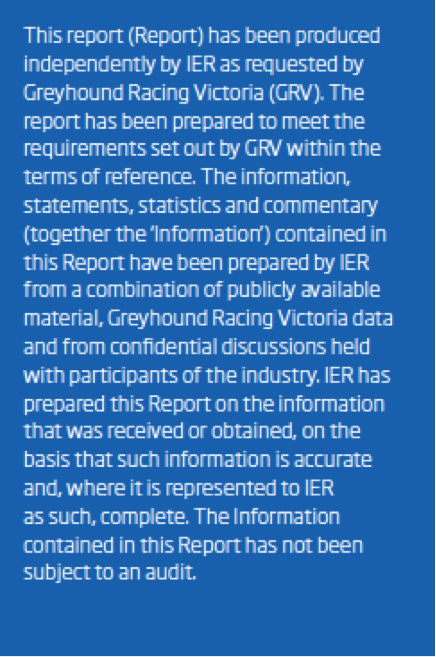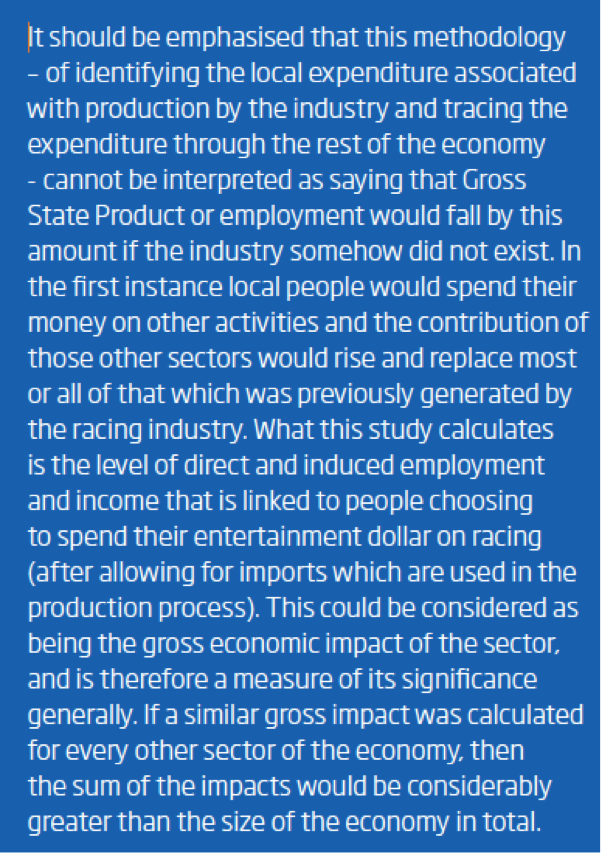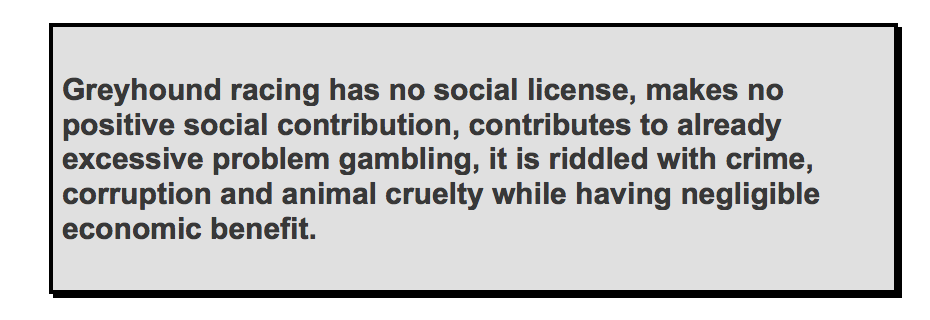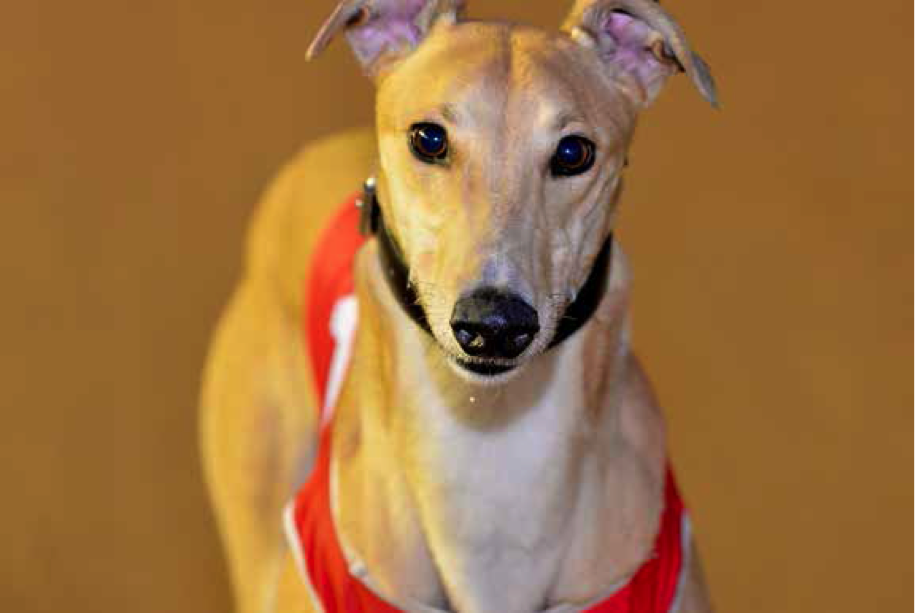
The recently released “Size and Scope of the Victorian Greyhound Racing Industry” report [1], states that in 2015-2016, the industry was responsible for generating more than $408.6 million dollars in value added contribution to the Victorian economy.
The claim is made by GRV that “Greyhound racing contributes hundreds of millions of dollars annually to Victoria’s economy through direct expenditure, salaries, flow-on effects and profits as well as creating thousands of jobs, mainly in regional communities.” [2].
In accepting the claims made by the report, it needs to be noted that:
- There are significant problems with the validity of the IER as it is based on
unaudited data provided by the racing industry itself, as stated in the report’s
disclaimer (see below). - It has also been prepared “to meet the requirements set out by GRV within their terms of reference”. Thus, the report cannot be expected to provide objective or unbiased data. Rather, it has been produced to portray the industry in the most positive light possible.
Paste In 1: Report Disclaimer


Bias is evident in the way the statistics have been constructed and reported. For example, it states its key findings at the beginning of the report as follows:
Paste In 2: Key Findings

Expenditure
As shown in Paste In 2, the noted direct expenditure amount is $298.3 not the $408.6 million highlighted by GRV above.

Value-added expenditure includes any expenditure that is not directly related to the industry, and it is this amount that is the larger figure of $408.6. As noted in the report itself, this expenditure would not necessarily fall if the industry ceased to exist as local people would spend their money on other activities and therefore, the contribution of those other sectors would rise and replace that generated by the industry (see Paste In 3 – taken from the report).
Paste In 3: Methodology Note in the Size and Scope Report


Employment
Upfront in the report as shown in Paste in 2, it is stated that there are the equivalent of 2,888 full-time jobs (FTE) generated by the industry but later in the report, it is made clear this figure includes indirect jobs. In fact, the total of direct FTE jobs is 1,216.
On page 23 the report states: “In 2015/16, the economic activity generated by the Victorian greyhound racing industry directly sustained 1,216 full time equivalent positions in Victoria. In addition to the direct employment impact, the activities of the greyhound racing industry also help to sustain a further 1,672 FTE jobs in support industries.”

As with direct expenditure, the indirect jobs currently supported by greyhound racing would be absorbed by the consequent increased size of other sectors if greyhound racing ceased to exist.
It is also noteworthy that, in its 2015 Industry report for Horse and Dog Racing [8], IBISWorld, concluded that “Industry revenue has been declining due to flat attendance numbers” and industry revenue is declining at a compound annual rate of 2.3%.
Greyhound Racing is a Gambling Industry
In their 2014 piece, Markham and Young state “The growth of ‘Big Gambling’ in Australia is an ongoing class project. It is one that has transferred, with industrial efficiency, billions of dollars from the pay packets of the working classes to the bank accounts of a super-rich elite.” [3]
They argue that a viable gambling industry without the extensive exploitation of the Australian working class in unimaginable since the data show that gambling problems are concentrated amongst the poorest social groups in Australia, and gambling revenue largely depends on problem gamblers [3].

Problem Gamblers
The data indicate that gambling industries do not create “new jobs”. Rather, they simply divert employment from other sectors and they don’t create new wealth either. Rather, they transfer wealth from poor to rich. Moreover, gambling likely reduces economic activity by diverting gamblers away from productive labor [3].

According to the Productivity Commission, as many as 170,000 Australian adults face significant gambling problems and a further 350,000 are vulnerable. Of concern, for every addicted gambler, there are 10 more people who are seriously affected. This includes families, friends and employers. According to the Commission, 60% of problem gamblers who have sought counselling, have spoken of suicide. As many as 400 suicides each year can be attributed to addictive gambling [4].

Psychological Distress and Problem Gambling
It is a known fact that the greyhound racing industry destroys thousands upon thousands of animal lives. It is also clear that it significantly contributes to the psychological distress and financial ruin of thousands upon thousands of Australian humans, most of who are already battling in our society [3].
A 2015 Australian Psychological Society survey into Stress and wellbeing, reported a strong association between gambling and psychological distress including severe anxiety and depression [5]. Governments themselves have acknowledged this relationship [6].
The evidence points to a desperate need to reduce gambling access and to make it less attractive so that people vulnerable to this societal vice are not so easily seduced. The irony is that while touting the economic benefits of the greyhound racing industry, governments are pouring millions of dollars into responsible gambling funds aimed at addressing the “risks of problem gambling and associated harms to the community.” [7].
Why not just shut down greyhound racing and at least circumvent the problem associated with this one form of gambling for which the social license has well and truly expired?
Let’s get the dogs off the track and onto the sofa where most Australians would like them to be.


References
- Size and Scope of the Victorian Greyhound Racing Industry.
http://www.grv.org.au/wp-content/uploads/2017/05/GRV_VGRI.pdf - New report highlights greyhound racing’s economic contribution to Victoria’s
economy. http://www.grv.org.au/vgri/ - Markham, F., & Young, M. (March, 2014). Who winds from ‘Big Gambling’ in Australia? The Conversation. https://theconversation.com/who-wins-from-big-gambling-in-australia-22930
- Maslen, G. (2012). Waiting for the wins. http://www.aph.gov.au/sitecore/content/Home/About_Parliament/House_of_Representatives/About_the_House_Magazine/Previous/ATH45/waiting.
- Australian Psychological Society (2015). Stress and wellbeing: How Australians are coping with life. https://www.psychology.org.au/Assets/Files/2014-APS-NPW-Survey-WEB-reduced.pdf
- Stress and Wellbeing report 2015 https://www.responsiblegambling.vic.gov.au/information-and-resources/whats-new/stress-and-wellbeing-report-2015
- Problem gamblers get more help in budget. http://westernweekender.com.au/2017/06/problem-gamblers-get-more-help-in-budget/
- IBISWord (2015) IBISWorld Industry Report R9120 Horse and Dog Racing in Australia.
A. The Expenditures of the Racing Industry
The so-called “Size & Scope” reports that the Victorian and other racing industry sectors regularly produce are designed to exaggerate the economic importance of the industry, in an attempt to justify the continuation of their existence. One of the main ways they accomplish this exaggeration is by counting expenditures of money by industry participants as a major part of its “contribution” to the economy.
There are two main objections to such a methodology:
First, many of those expenditures would be made even if the greyhound racing industry did not exist. People still need to eat, buy clothes, and pay for transportation and shelter. If they have land, they pay for fencing and construction of buildings and other infrastructure. If they own pets, they pay for food, veterinary care, and grooming. They spend money on entertainment and hobbies. They may spend money on non-racing forms of gambling and gaming activities, if they are so inclined.
Second, spending money is not an actual contribution to an economy, as it merely exchanges money for something else of equal value. Value is not added by consumption of goods, but by their production. In fact, expenditures are actually a negative factor from the point of view of the racing industry itself; a true calculation of the net contribution to the economy would involve subtracting expenditures from the value of the industry’s production output — not adding them together, as the Size & Scope people always do.
B. The Revenue of the Racing Industry
The greyhound racing industry is a subsection of the gambling industry. Gambling creates no value to an economy, inasmuch as every dollar gained by one gambler is a dollar lost by another.
The bulk of the revenue coming into the racing industry is gambling proceeds (i.e. money lost by gamblers) which go into racing purses, and ultimately into the pockets of industry participants. Still another source of revenue for dog racers is government subsidies out of the public purse. Another source of revenue is racetrack gate receipts, for those tracks that charge an admission fee (some don’t). There is also advertising and sponsorship money, paid to the industry by private companies and individuals, as a business expense. In every case, the revenue produced by the racing industry is simply a transfer of money from many pockets into the pockets of the industry participants, without any real value being created for the overall economy.
C. Greyhound Racing’s Net Contribution is Negative
If greyhound racing were simply an exercise in moving money around the economy, it would not be particularly objectionable from a purely economic standpoint, even though it produces nothing of value.
But it also produces harms, which carry no small economic cost. Those harms are never considered in these “Size & Scope” reports. They include:
1. The well-known negative impacts on the health, well-being, comfort, and lifespan of the greyhounds themselves.
2. The well-known phenomenon of gambling addiction, which ruins lives, disrupts the well-being of families, and requires the expenditure of millions of dollars in treatment and rehabilitation costs.
3. The overbreeding of greyhounds, which contributes directly to the oversupply of adoptable dogs, and thus results in additional costs of feeding and housing unwanted dogs, and the inevitable killing of otherwise healthy dogs of all breeds.
4. The enormous private costs in time, money, and emotional health of the volunteer greyhound rescue and rehoming people and groups, who deal with a constant stream of dogs cast off by the racing industry, that require veterinary care, licensing, training, feeding, housing, loving attention, and placement in suitable adoptive homes.
Balanced against an industry that produces nothing of real value and survives mainly because of government subsidies and freely-flowing gambling money, these harms tip the moral and economic scales against the continuation of greyhound racing in Victoria and everywhere else.
Let’s not kid ourselves that animal abuse is “entertainment”, so don’t use greyhound abuse as entertainment. Let’s instead wipe out this disgusting “sport” that pays little to NO attention to animal welfare; rather, it promotes drugging, torture, abuse & wastage of the dogs – as well as a lingering & terrible death of countless bait animals. There is NO VALUE in continuing this ghastly & sick “entertainment” that promotes gambling addiction & animal cruelty.